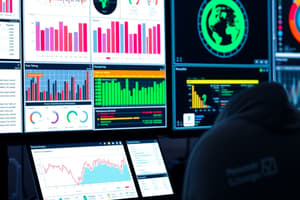Podcast
Questions and Answers
Which component is NOT part of the information system process?
Which component is NOT part of the information system process?
- Disseminate
- Store
- Collect
- Analyze (correct)
What is the purpose of user feedback in an information system?
What is the purpose of user feedback in an information system?
- To collect data for marketing purposes
- To provide statistical analysis of user demographics
- To track the system's performance metrics
- To enhance the system based on user experiences (correct)
Which of the following describes error reporting in an information system?
Which of the following describes error reporting in an information system?
- It generates marketing leads through data collection.
- It monitors user engagement metrics.
- It helps identify root causes of errors for troubleshooting. (correct)
- It exclusively captures user satisfaction ratings.
What does the feedback mechanism within an information system help to achieve?
What does the feedback mechanism within an information system help to achieve?
Which method is NOT a way to collect user feedback?
Which method is NOT a way to collect user feedback?
What components make up a computer-based information system (CBIS)?
What components make up a computer-based information system (CBIS)?
Which benefit is associated with employing a good computer-based information system?
Which benefit is associated with employing a good computer-based information system?
What role do information systems personnel play in a CBIS?
What role do information systems personnel play in a CBIS?
What is the primary purpose of a data retention procedure?
What is the primary purpose of a data retention procedure?
What is the purpose of a procedure in a CBIS?
What is the purpose of a procedure in a CBIS?
What does the user authentication procedure ensure?
What does the user authentication procedure ensure?
Which aspect is essential for maintaining backed-up data?
Which aspect is essential for maintaining backed-up data?
In the context of backup processes, what would be an inappropriate choice for backup media?
In the context of backup processes, what would be an inappropriate choice for backup media?
Why is it important to have guidelines for data disposal in a data retention procedure?
Why is it important to have guidelines for data disposal in a data retention procedure?
Which component is NOT typically included in a data retention procedure?
Which component is NOT typically included in a data retention procedure?
What does 'All Rights Reserved' imply about the usage of material?
What does 'All Rights Reserved' imply about the usage of material?
In what context is reproduction of the material allowed?
In what context is reproduction of the material allowed?
Which of the following statements is true regarding the distribution of the material?
Which of the following statements is true regarding the distribution of the material?
What are the limitations placed on the use of the material?
What are the limitations placed on the use of the material?
Under what condition might copying not be permitted?
Under what condition might copying not be permitted?
What is a primary function of a Transaction Processing System (TPS)?
What is a primary function of a Transaction Processing System (TPS)?
Which of the following best describes an ERP system?
Which of the following best describes an ERP system?
Which type of information system focuses on operational efficiency and decision-making support primarily for managers?
Which type of information system focuses on operational efficiency and decision-making support primarily for managers?
What is one of the key roles of a Knowledge Management System (KMS)?
What is one of the key roles of a Knowledge Management System (KMS)?
Which of the following is NOT a type of e-commerce?
Which of the following is NOT a type of e-commerce?
Which of the following industries commonly utilizes information systems?
Which of the following industries commonly utilizes information systems?
What component is critical for designing successful e-commerce solutions?
What component is critical for designing successful e-commerce solutions?
Which type of system is primarily concerned with decision-making support through analyzed data?
Which type of system is primarily concerned with decision-making support through analyzed data?
What is a key decision for new e-commerce companies regarding their website?
What is a key decision for new e-commerce companies regarding their website?
What type of reports do Management Information Systems (MIS) typically generate?
What type of reports do Management Information Systems (MIS) typically generate?
Flashcards are hidden until you start studying
Study Notes
Information Systems
- An information system (IS) is a set of interrelated elements that collect (input), process, store, disseminate data and information, and provides feedback to monitor and control its operation.
- The system should continuously meet its set goals and objectives.
Feedback Mechanisms
-
User Feedback:
- Systems can collect feedback from users about their experience, satisfaction, and suggestions for improvement.
- This feedback can be gathered through surveys, user feedback forms, or online reviews.
- Information gathered can be used to identify usability issues, functionality gaps, or areas where the system can be enhanced to better meet user needs.
-
Error Reporting:
- When errors occur within the system, a feedback mechanism can capture and report them.
- This feedback helps identify the root causes of errors, troubleshoot issues, and implement corrective actions to prevent future occurrences.
Computer-Based Information Systems (CBIS)
- A CBIS is a single system composed of hardware, software, databases, networks, people, and procedures.
People
- Successful systems can increase job satisfaction and worker productivity.
- Information systems personnel manage, run, program, and maintain the system.
Procedures
- Procedures define the steps to achieve a specific end result, such as entering a customer order or paying a supplier invoice.
- When using a CBIS, it's important to follow procedures for operating, maintaining, and securing the system.
Procedures Examples
- User authentication procedure: outlines the steps for users to log in securely to the system.
- Data retention procedure: specifies the guidelines for retaining and disposing of data within the CBIS.
Business Information Systems
- Information systems are used in all functional areas of a business organization, including accounting and finance, customer service, human resources, manufacturing, research and development, and sales and marketing.
Industry Usage
- Information systems are used in nearly every industry such as agriculture, finance, healthcare, mining, professional services, and retail.
Types of Information Systems
-
Transaction Processing Systems (TPS):
- A TPS is used to perform and record completed business transactions (like payments to employees, suppliers, or sales to customers).
- An example of a TPS is the Point-of-Sale (POS) System in a retail store that records sales transactions, updates inventory levels, and processes customer payments.
-
Management Information Systems (MIS):
- An MIS provides routine information to managers and decision makers.
- MIS focuses on operational efficiency and provides standard reports generated using data and information gathered from TPS.
- An example is a sales dashboard providing managers with visualized data on sales performance, customer demographics, and product trends.
-
ERP Systems:
- ERP systems are a set of integrated programs or modules that manage the vital business operations for the entire organization. These modules include human resource management, customer relationship management (CRM), financial management, warehouse management, and more.
-
Knowledge Management Systems (KMS):
- KMSs are used to store and retrieve knowledge to improve organizational collaboration.
- Examples include customer support, where agents/employees can access a knowledge base to resolve customer issues quickly and effectively. Another example is product development, where best practices and technical expertise can be shared across teams to accelerate innovation.
Other important Information Systems
- Decision Support Systems (DSS)
- Geographic Information Systems (GIS)
- Learning Management Systems (LMS) - It can be considered a type of knowledge management system.
Electronic Commerce (E-Commerce)
- E-commerce involves the exchange of money for goods and services over electronic networks.
- Forms of e-commerce include:
- Business-to-Business (B2B)
- Business-to-Consumer (B2C)
- Consumer-to-Consumer (C2C)
- Government-to-Citizen (G2C)
- Government-to-Business (G2B)
- Government-to-Government (G2G)
E-Commerce Strategies
- Many organizations utilize both buy-side e-commerce (purchasing goods and services from suppliers) and sell-side e-commerce (selling products to customers).
- Successful e-commerce solutions are designed to be highly scalable and can be upgraded to meet unexpected user traffic.
- Key decisions for a new e-commerce company include determining whether to host its own website or utilize a third-party web service provider.
Summary
- The value of information is directly linked to its ability to help decision-makers achieve the organization's goals.
- Information systems are composed of fundamental components that must be carefully assembled and integrated to function effectively.
- Organizations use a variety of information systems to improve how they conduct business and make data-driven decisions.
Studying That Suits You
Use AI to generate personalized quizzes and flashcards to suit your learning preferences.




